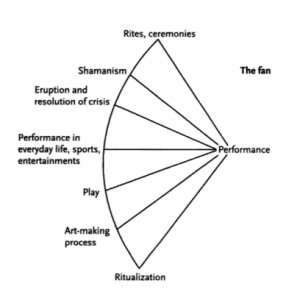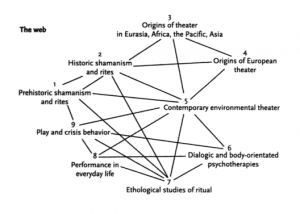Everyday as a performance theories diagrams – posted 12 March.
In the beginning stages of the rehearsal process we decided to explore different practitioner theorist to develop our initial ideas. It has been suggested by many theatre specialists that performance can be applied to different situations within our everyday life. Within the arts, performance can become multidisciplinary, where different theatrical elements, such as movement, can all become combined. One of the theorists that we explored at the beginning of our rehearsal process was Richard Schechner. He is a theorist that recognised how performance can be seen within our everyday lives, a sense of an everyday art. ‘The recognition that our lives are structured according to repeat and socially sanctioned modes of behaviour raises the possibility that all human activity could potentially be considered as “performance”.’ (Carlson: 1996, P. 4) This meant that each day, every human was performing subconsciously from the moment that they awake in the morning to the moment that they go back to sleep. Schechner’s belief in everyday performance lead him to concentrate on Restoration of Behaviour, ‘restored behaviour is “me behaving as if I were someone else,” or “as I am told to do” or “as I have learned” (Schechner 2002, P. 34). In terms of everyday life, Schechner believes restored behaviour shows our everyday performance of how we have been brought up since a child. This could be the way in which we are taught to eat, dress ourselves or personal characteristics. Schechner creates this theory for theatre directors to reflect how performance is surrounding us humans everyday.
Schechner created two diagrams to help explain his theories of performance, The Fan and The Web. ‘The fan presents performance as an organized spectrum of categories, and the web reveals the dynamic influences and interconnections’ (http://www.icosilune.com/2009/01/richard-schechner-performance-theory/, 2009 ). With the Fan structure, Schechner believed the higher level in the fan gains an orderly function performance. Whereas, the lower within the fan the more disorderly performance. He suggest that both ends of the fan can meet which establishes ‘a new ritual, which requires a great deal of play and freedom, then becomes a new structure of order’ (http://www.icosilune.com/2009/01/richard-schechner-performance-theory/, 2009) . The web is structured around his own views on performance, numberd within importance.
Altogether we felt that schechner was important to study, as we gained an understanding into how common a performance is within the everyday life. This helped us to reflect how people are unaware of their own everyday behaviour. We felt we wanted to explore this within our rehearsal process and adapt this into our performance. We felt reflecting the everyday life, may make a spectator reflect their own everyday life and whether there are subconsciously performing movement. Lastly we felt this type of performance would be more relatable to spectators as they would be able to relate to our intentions. Altogether we studied schechners believes to help identify different modes of performance.
Carlson,M ( 2004) Performance a Critical Introduction, 2nd edn. United Kingdom, Routledge.
Schechner, R (2006) Performance Studies- An Introduction, 2nd edn. London, Routledge.
(http://www.icosilune.com/2009/01/richard-schechner-performance-theory/, 2009) ( Accessed: 13/5/2012)
By Christie Asplin.


Comments are closed.